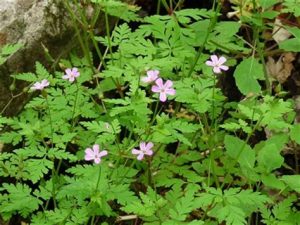Yarrow Achillea millefolium
Common Name: Soldiers Woundwort, Staunch Blood, Carpenter’s Woundwort, Knight’s Milfoil, Nosebleed, Bloodwort, Old Man’s Pepper, Noble Yarrow, Thousand Leaf, Thousand Seal, Old Man’s  Pepper, Devil’s Nettle
Pepper, Devil’s Nettle
Origin: Native to the northern hemisphere
Propagation: Root division or seed
A perennial, ground spreading herb with fragrant fern-like leaves 5-20cm long. Flower stems (white) are 30-60cm in length, often used in dried floral arrangements.
Yarrow will grow in sun or part shade and spreads easily in rich, loose soil. It seems to have a beneficial impact on other herbs and plants nearby as well as attracting beneficial insects, including ladybirds and predatory wasps. Yarrow also has insect repelling properties and can be used with other herbs as a spray on plants. It is also a great addition to your compost heap, working as an ‘activator’ of the composting process.
 Prune after flowering.
Prune after flowering.
Fresh yarrow leaves have a peppery taste and can be finely chopped and a little-used in salads, cheese dips or as a garnish. Leaves can even be steamed as used like spinach. Dried leaves, when powdered, add a pepper-like flavouring to your meals.



 Both grow in this area and can handle a variety of soils, as long as they are reasonably deep and well drained. Trees can be pruned similar to an apple – open vase and they require watering until well established. They can also be grown in pots (dwarf form) so they’re easier to protect from birds.
Both grow in this area and can handle a variety of soils, as long as they are reasonably deep and well drained. Trees can be pruned similar to an apple – open vase and they require watering until well established. They can also be grown in pots (dwarf form) so they’re easier to protect from birds. For 10 litres dissolve 100g copper sulphate with hot water in a plastic bucket, then pour into sprayer 3/4 filled with cold water. Now mix 100g hydrated lime (calcium hydroxide) with a small amount of water to make a slurry and add to your copper sulphate solution. Stir and add water to make 10 litres. Add 50ml white oil to assist with sticking to leaves. Stir constantly to avoid nozzle blockage.
For 10 litres dissolve 100g copper sulphate with hot water in a plastic bucket, then pour into sprayer 3/4 filled with cold water. Now mix 100g hydrated lime (calcium hydroxide) with a small amount of water to make a slurry and add to your copper sulphate solution. Stir and add water to make 10 litres. Add 50ml white oil to assist with sticking to leaves. Stir constantly to avoid nozzle blockage.